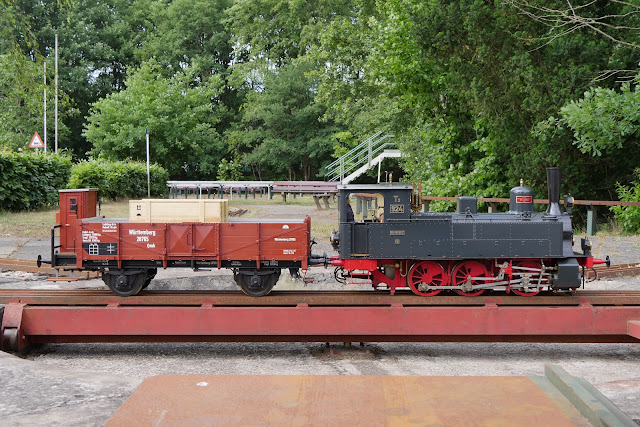A second wagon for the T3 is a so called "Bier-Kühlwagen" (refrigerated wagon for beer transport).
Again a model of Märklin will be the example that is scaled up to 7¼" gauge. I've got a model in gauge 1 and H0. Besides the model there is a picture of one of the originals that were build for the Württembergische Hohenzollernsche Brauerei Gesellschaft Englischer Garten Stuttgart. The two wagons, number 60048 and 60049 were build by the Maschine Fabrik Esslingen in 1909.
These insulated wagons were cooled by inserting large blocks of ice in a tray, that was mounted under the roof. The insulation was achieved with double wooden walls, roof and floor, that was stuffed with wool and hay in between. Modern materials didn't existed then.
Besides cooling, it was also possible to heat the wagon, with a small coal burning hearth. This way the beer could be protected for freezing in the winter and prevented for heating up in the summer. A correct and constant temperature is important for the quality of the beer.
These insulated wagons were cooled by inserting large blocks of ice in a tray, that was mounted under the roof. The insulation was achieved with double wooden walls, roof and floor, that was stuffed with wool and hay in between. Modern materials didn't existed then.
Besides cooling, it was also possible to heat the wagon, with a small coal burning hearth. This way the beer could be protected for freezing in the winter and prevented for heating up in the summer. A correct and constant temperature is important for the quality of the beer.
This beer company "Englischer Garten" is not existing anymore, but was incorporated in the Stuttgarter Hofbräu brewery.
The wagon will serve as "toolbox on wheels", so all the firing and maintenance tools are nicely packed for a day on the track......and maybe there is room for a few beers as well 😀
The 7¼ model is designed in Solidworks and will be a working model. The under carriage is a copy of the Omk open goods wagon, as described earlier on this blog, but with a slightly longer wheel base.
It is also equipped with the same brake gear as the Omk and I plan to make the super structure strong enough to sit on.
The first concept of the wagon. Details as the door closing mechanisms, steps, lamp irons, have yet to be designed.
A lot of parts for the under carriage were made when I was working on the Omk. Once the lathe or milling machine was setup for a certain operation, it is often quicker to make all the parts needed for both wagons in one batch.
An exception are parts where a lot of machining time is needed anyway.....
.... therfore axles, hornblocks and bearing houses were not made on forehand.
Cutting a groove in the hornblocks (5.5 mm wide and 6 mm deep) is done on the shaping machine. This is even quicker than the milling machine, because hefty cuts can be taken.
A big drill is used for opening out the hornblock plate.
With a boring tool the hole is made to the exact dimension of 37.50 mm. Working to a close tolerance makes it possible to obtain a strong glued joint with the bearing house.
For a model engineer this is already a 'heavy' machining operation.
Work in progress
The horn cheeks and axle bearing housing completed.
Assembled with parts that were made earlier, the under carriage is already taking shape.
Drilling with a standard drill in thin plate may cause triangle shaped holes. To overcome this, a piece of emery cloth is placed between the drill and plate. This will 'fill' the clearance angle and gives support to the drill. The result is a nice round hole.
The support brackets for the handbrake axle. Cut to shape and the radius filed.
At first I had no intention to make a handbrake as well on this wagon. My son advised me do it, as a backup driving truck, and extra braking assistance when going down hill with a heavy train.
The brake handle was CNC milled from 3 mm strip.
A square hole gives a strong connection to the brake shaft.
Drilling the holes for bolting the handbrake shaft. The frame just fitted on the drilling machine, and so saved some time in disassembling the it otherwise for drilling.
The brake assembly. Just picking the parts from the box and assemble them; the time spend on them when making the Omk wagon is now speeding up the job.
The small shafts (only 4 mm in diameter) for the brake blocks are made of silver steel for rigidity.
They are glued (Loctite 601) into a hole of 25 mm deep in the triangle.
A first test on our club track.








































